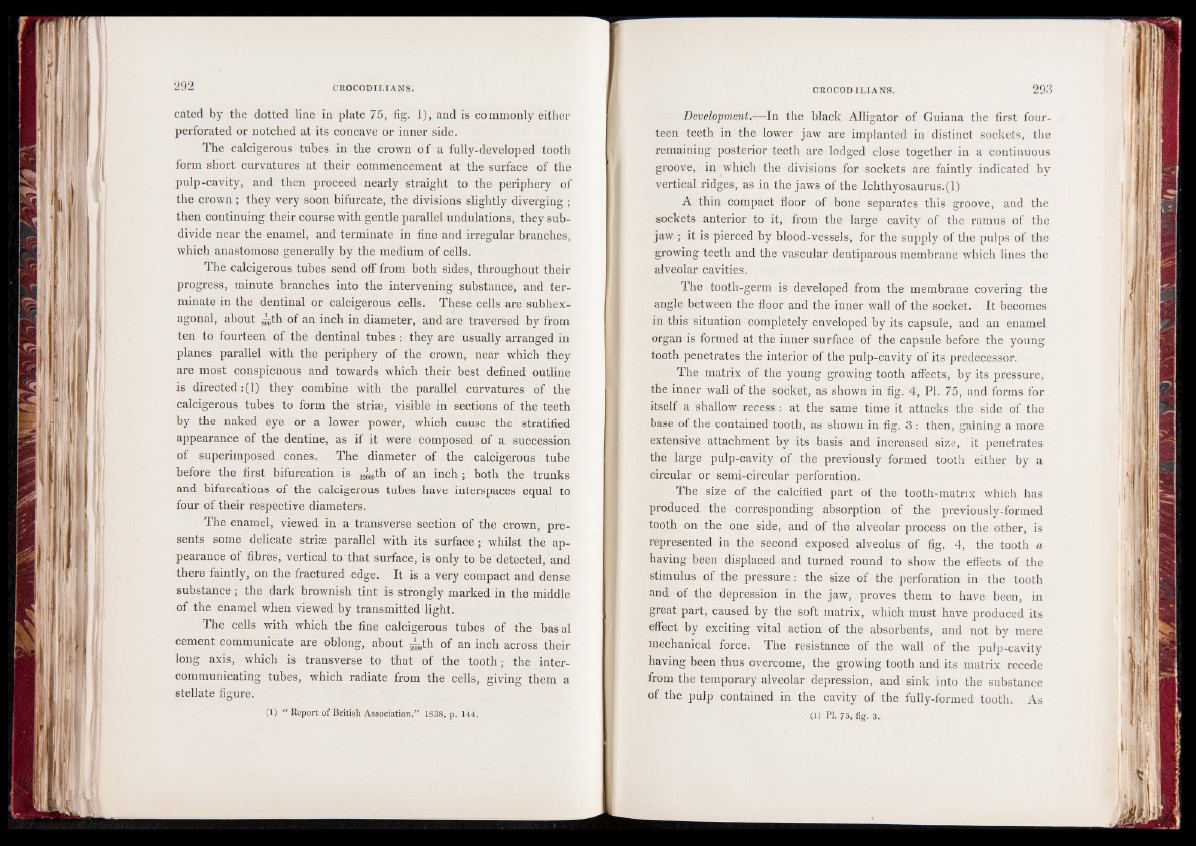
cated by the dotted line in plate 75, fig. 1), and is commonly either
perforated or notched at its concave or inner side.
The calcigerous tubes in the crown of a fully-developed tooth
form short curvatures at their commencement at the surface of the
pulp-cavity, and then proceed nearly straight to the periphery of
the crown ; they very soon bifurcate, the divisions slightly diverging ;
then continuing their course with gentle parallel undulations, they subdivide
near the enamel, and terminate in fine and irregular branches,
which anastomose generally by the medium of cells.
The calcigerous tubes send off from both sides, throughout their
progress, minute branches into the intervening substance, and terminate
in the dentinal or calcigerous cells. These cells are subhex-
agonal, about gjjth of an inch in diameter, and are traversed by from
ten to fourteen of the dentinal tubes : they are usually arranged in
planes parallel with the periphery of the crown, near which they
are most conspicuous and towards which their best defined outline
is directed :(1) they combine with the parallel curvatures of the
calcigerous tubes to form the striae, visible in sections of the teeth
by the naked eye or a lower power, which cause the stratified
appearance of the dentine, as if it were composed of a succession
of superimposed cones. The diameter of the calcigerous tube
before the first bifurcation is ^»th of an inch; both the trunks
and bifurcations of the calcigerous tubes have interspaces equal to
four of their respective diameters.
The enamel, viewed in a transverse section of the crown, presents
some delicate striae parallel with its surface ; whilst the appearance
of fibres, vertical to that surface, is only to be detected, and
there faintly, on the fractured edge. It is a very compact and dense
substance ; the dark brownish tint is strongly marked in the middle
of the enamel when viewed by transmitted light.
The cells with which the fine calcigerous tubes of the basal
cement communicate are oblong, about ^ th of an inch across their
long axis, which is transverse to that of the tooth; the intercommunicating
tubes, which radiate from the cells, giving them a
stellate figure.
(I) “ Report of British Association,” 1838, p. 144.
Development.—In the black Alligator of Guiana the first fourteen
teeth in the lower jaw are implanted in distinct sockets, the
remaining posterior teeth are lodged close together in a continuous
groove, in which the divisions for sockets are faintly indicated by
vertical ridges, as in the jaws of the Ichthyosaurus.(l)
A thin compact floor of bone separates this groove, and the
sockets anterior to it, from the large cavity of the ramus of the
jaw ; it is pierced by blood-vessels, for the supply of the pulps of the
growing teeth and the vascular dentiparous membrane which lines the
alveolar cavities.
The tooth-germ is developed from the membrane covering the
angle between the floor and the inner wall of the socket. It becomes
in this situation completely enveloped by its capsule, and an enamel
organ is formed at the inner surface of the capsule before the young
tooth penetrates the interior of the pulp-cavity of its predecessor.
The matrix of the young growing tooth affects, by its pressure,
the inner wall of the socket, as shown in fig: 4, PI. 75, and forms for
itself a shallow recess : at the same time it attacks the side of the
base of the contained tooth, as shown in fig. 3: then, gaining a more
extensive attachment by its basis and increased size, it penetrates
the large pulp-cavity of the previously formed tooth either by a
circular or semi-circular perforation.
The size of the calcified part of the tooth-matrix which has
produced the corresponding absorption of the previously-formed
tooth on the one side, and of the alveolar process on the other, is
represented in the second exposed alveolus of fig. 4 , the tooth a
having been displaced and turned round to show the effects of the
stimulus of the pressure: the size of the perforation in the tooth
and of the depression in the jaw, proves them to have been, in
great part, caused by the soft matrix, which must have produced its
effect by exciting vital action of the absorbents, and not by mere
mechanical force. The resistance of the wall of the pulp-cavity
having been thus overcome, the growing tooth and its matrix recede
from the temporary alveolar depression, and sink into the substance
of the pulp contained in the cavity of the fully-formed tooth. As
(l-) PI. 75, fig. 3..